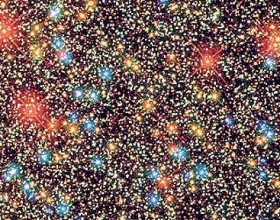 The chart shows the sky at midnight at the start of October.
The chart shows the sky at midnight at the start of October.
The positions of the stars on other nights can be found from previous charts, for they rise two hours earlier each month. Thus, the appearance of the sky at 10 pm at the beginning of October (except for the Moon and planets) is identical to that a month ago at midnight. The Moon, which was full on the 4th, and new on the 18th, is shown in its various phases. The hazy area represents the billions of stars of the Milky Way. Constellations are in capitals, and the brighter stars are in lower case. The larger the circle denoting them, the brighter the star.
This month’s image shows the globular cluster Omega Centauri, the biggest and brightest globular cluster in the sky, covering an area larger than the full Moon. The picture is a triumph of the newly repaired Hubble Space Telescope. It is 17,000 light-years away, 150 light-years across with more than a million stars. I have never seen such a dazzling astronomical picture. Even a few months ago such detail would have been impossible.
The stars here are 10,000 times closer together than those in our neighbourhood. There are many faint yellow-white stars smaller than our Sun, several yellow-orange red giants, and many blue stars. There should also be more than one black hole: with so much stellar material packed together, a lack of black holes is inconceivable. Only life would be lacking. Hard radiation would surely prevent evolution.
Globular clusters are the oldest objects in the universe. They blazed out billions of years even before there were any galaxies, and they may shine long after the galaxies are gone.
This is the best time of year to see the star Fomalhaut, near the southern horizon in Piscis Austrinus. It is a near neighbour, only 25 light-years away, and the centre of a newly forming planetary system in the shape of dusty debris.
The appearance in the east this month of the brilliant Pleiades star cluster in Taurus heralds the approach of winter. The Pleiades are surely one of three great spectacles of the northern sky the others being the Summer Triangle (now moving towards the western horizon), and, to be visible next month, the glorious Belt and Sword of Orion.
But the Pleiades are on stage now. Through binoculars they are stunning. At a distance of 440 light-years and seven light-years across, they are extremely bright since they are young, hot stars no more than about 100 million years old. Their apparent size is four times that of the full Moon. They are called the Seven Sisters, but in fact several hundred stars belong to the cluster.
















